Light rail transit (LRT) has ushered in a revival of electric railways in our streets, along underutilized railroad lines and on new rights-of-way. Around the world today, light rail vehicles (LRVs) sport modern designs, liveries and technology, inspiring new generations of admirers. This East Penn Traction Club page is an overview of resources and methods to easily model today's light rail scene. This is not an exhaustive list and any models mentioned are examples of what exist. Please visit our Manufacturer/Dealer page to find a list of who produces LRV products.
Before we go totally modern, we need to pay our respects to the most modern of the old streetcars and trams.
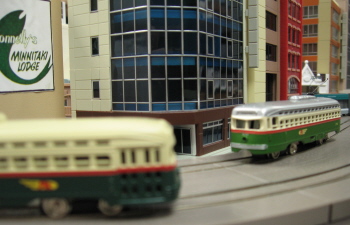 Bachmann N scale PCCs on an EasyTrolley layout. Tomix track and street, pre-made buildings by Kato, Tomix and Model Power/Pola. | The American PCC car was the product of a focused customer/builder/supplier technology development program. It proved to be such a successful design that PCC cars soldiered on into modern times, racking up over half a century of mainstream service. Even today, updated heritage PCCs operate across the USA in places like Philadelphia, Waukesha and San Francisco. Very economical model PCC cars, ready-to-run in 2-rail mode (not from overhead wire) are available from Bachmann in both HO scale and the smaller N scale. Both can be converted to overhead operation, although the N scale version is harder to convert. The HO cars can also be modified to lower the carbody and to negotiate tighter turns. The earlier Bachmann N-scale model trolleys have a well-known problem with axle gears cracking and then binding. It's best to avoid older cars with white plastic axle gears; buy the newer cars that come in hard plastic cases and have black plastic axle gears. Bachmann cars, although inexpensive entry-level products, can be made to run pretty well. Remove or overpaint those toy-like passenger silhouettes for a more realistic appearance. |
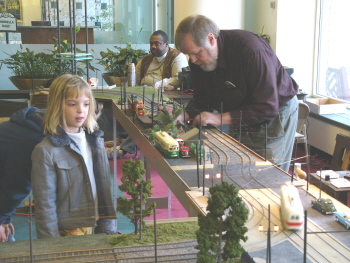 Modern recognizable O scale PCCs are always crowd pleasers at EPTC public shows. | Bowser still offers its cast metal HO PCC kit (now with modern drive components) that you must clean up, assemble and paint yourself. In O scale, beautiful (and expensive) unpowered PCCs in many paint schemes have been made by St. Petersburg Tram Collection in Russia. MTH has produced 3-rail "toy train" ready-to-run PCCs in many paint schemes. Corgi has produced 1:50 scale diecast unpowered PCCs in many paint schemes, and several specialty manufacturers offer kits to power them. Finally, traditional cast metal trolley body kits are also still available second-hand. |
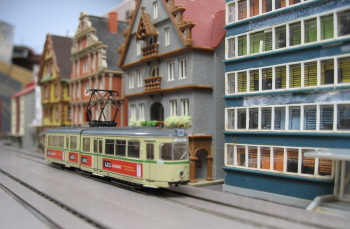 Arnold N scale Duewag tram on a German-themed EasyTrolley layout. | Similar classic modern cars from Europe are also available in model form. A few years ago the Arnold company of Germany produced two-section articulated Duewag trams in N scale, decorated for a number of cities and in a number of paint schemes. These cars, now out of production, are fairly expensive but they are well-detailed and solid engineering masterpieces that run very well. They feature an all-metal pantograph, and they come ready to operate either 2-rail or from overhead wire with just a turn of an underfloor switch. |
 Roco HO scale articulated tram. | In HO scale, European manufacturer Roco produced a variety of classic modern articulated multi-section European trams. These appear fairly regularly on internet auction websites. |
Models of today's LRVs generally come from Japan or Europe, so they tend to be replicas of cars from those places. Nonetheless, actual LRV designs have been getting more alike in appearance and more international all the time. Many of these models would look right at home on any model layout of a modern "world city."
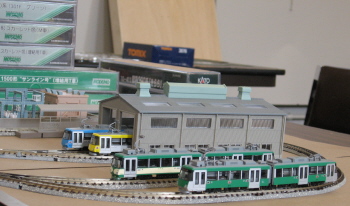 Modemo Tokyu 300-series LRVs at the carbarn. | A prolific manufacturer of N gauge electric railway cars is Modemo, which is a brand of the large modelmaker Hasegawa of Japan. Modemo has offered a succession of Japanese-prototype models. (See www.ve3ho.ca/n-scale/n-scale-trolleys.htm for a compendium of N scale models, including Modemo's.) You have to buy them when they are made available. After that, they are gone, unless Modemo decides to produce another batch. Most Japanese electric railways use raised station platforms, so many models do not have low doors or stepwells for street-level loading. Some Modemo models look very much like American steel interurbans, and some even feature classic American Baldwin trucks. A great LRV model by Modemo is their series of Tokyu Type 300 two-section articulated cars. The Tokyu Railway, or Setagaya line, is a small electric railway with a fleet of these modern cars, each with a different paint scheme resulting in a variety of models. The cars have stepwells and low doors on both sides, so they look good whether running left-hand (as in Japan) or right-hand. Modemo cars are well-engineered, quiet, smooth-running cars. They can be bought from Japan through webpages in English using credit card or Paypal, or through internet auction sites (including a store on eBay called Plaza Japan) for under US$100. (Modemo also offers some HO scale electric railway cars, although none are modern light rail in nature.) |
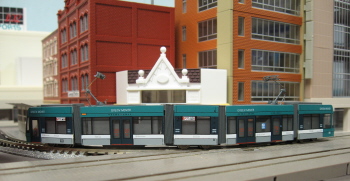 Hiroshima Green Mover, an N scale Siemens Combino low-floor 5-section LRV. | Another modern LRV model in N scale is the multi-section Siemens standard low-floor "Combino" design offered through Hoedl Linie-8 in Germany, Aspen Models in the USA, and Dauphin Ltd. (Sato) in Japan. Hoedl Linie-8 also offers HO versions of many modern LRVs, as well as traditional European tram models in both scales. The N gauge models vary in details and are either three sections or five sections long to match the prototypes. Cars are produced representing Ulm and Erfurt (Germany), as well as Hiroshima and Nagasaki (Japan). These models feature metal pantographs which could be wired and made to work. Again, detail and design are excellent, but these cars are even more expensive than the Arnold model of the earlier Duewag trams. |
| Recently, Hornby/Rivarossi has been producing the Tram Duewag M8. | |
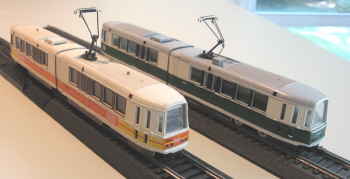 AHM HO scale Boeing SLRVs for MUNI (left) and Boston. The MUNI car has wired, inconspicuous brass tubes in the roof to accept trolley poles, and the pantograph has been wired and adjusted to reach higher. | In HO scale, AHM produced models of the US "Standard Light Rail Vehicle" built by Boeing for both MUNI in San Francisco and MBTA in Boston. The last of the real cars, which were problematic in operation, were just retired in 2007. The out-of-production, entry-level AHM models appear frequently at model train shows and on internet auction websites. The models, like the real SLRV cars, have their operational issues. They were made for AHM by Mehano (who still produces them and sells through distributors of Mehano products) in Yugoslavia and later Slovenia (the changing names cast on the underfloors are a history lesson in themselves!), and the motors are low-quality and spark. They can be made to run reliably, however. Another option is to buy a special replacement underfloor offered by specialty supplier Custom Traxx that uses the modern Bowser HO drive mechanism. The cars have metal pantographs that can be wired and made operational, or you can model prototypes with trolley poles added during the real cars' testing phase. The Car Works, an importer of custom brass models, imported Boeing SLRV cars some years ago in O scale and an HO brass San Diego U2 was imported by MTS in the late 1990s. These models show up for sale second-hand from time to time. Currently MTS is importing a fine brass model of a San Diego SD100 , a similar vehicle also ran in Salt Lake City, Calgary, and Sacramento. |
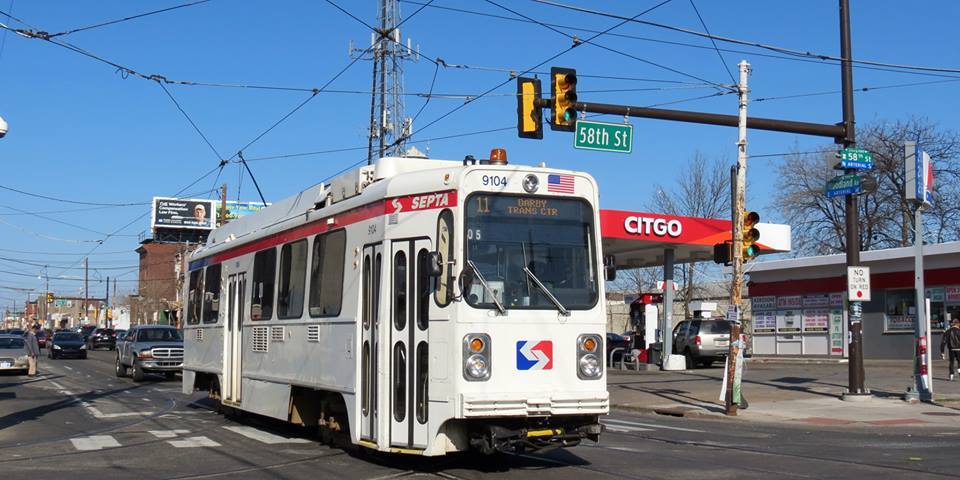 Philadelphia Kawasaki LRV Prototype (Photo credit: Roger DuPuis II) |
Beyond the mass-produced models of modern cars, specialty shops have offered modern LRVs as finished products, body shells or kits. Imperial Hobby Productions (IHP) in the past produced O scale finished unpowered and body shell versions of the Kawasaki-built LRVs operated by SEPTA in the city of Philadelphia. Decorated HO versions are offered by IHP and Island Model Works (undecorated), with the ability to be powered by a number of recommended drives (click here for an article in the March 2014 Trolleyville Times). Click here for a video by Charlie Long of the IHP LRV running on a layout. Other LRV models include the Portland LRVs by Island Model Works; HO resin LRVs for Toronto's CLRV, ALRV and SF MUNI Breda LRV by Miniatures by Eric; and Toronto LRVs in O scale by St.-Petersburg Tram Collection. Berkshire Car Shops offers the O scale Toronto CLRV kit and Steve Olsen wrote about it at www.torontotransitmodels.org. Shapeways 3-D printer has some US and Euro LRV bodies available in various scales. |
Well, that handles the cars themselves. How do we run them? Experienced, talented modelers traditionally have operated their cars in all scales on handlaid track, to get the tight curves and track switches that are so typical of trolley or tramway systems. They also become accomplished at soldering fine wires together in mid-air to construct wire overhead systems, from which the model trolleys actually get their DC power to run. It can all add up to a lot of investment of time and effort before enjoying the pleasure of operating your models.
Today, ready-to-run models can be combined with appropriately tight curves and switches, street paving systems and pre-made buildings. It is possible to start enjoying your own miniature contemporary urban light rail system without a heavy investment in modeling them all from scratch. You do have to dispense with having the overhead wire, or put it off until later.
For the latest on this aspect of model trolleys, check out Rich Kerr's Tomix EasyTrolley Site.
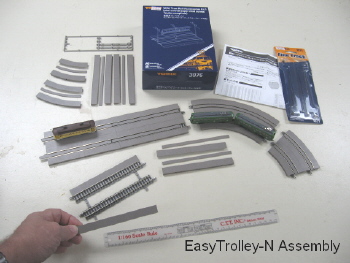 Tomix Fine Track, with Mini-curves and street kit pieces. | Late in 2005, Tomix, the model railway product line of the large Japanese model company Tomy, introduced N gauge tight-radius curves and track switches in its Fine Track system. (Fine Track is the equivalent of competitor Kato's Unitrack, with a molded roadbed base and a durable snap-together design.) In 2006 Tomix added a plastic street kit to its line, allowing paved street sections to be built around its "Mini" Fine Track products. Modelers have caught on quickly. East Penn club members, already well-versed in building trolley-specific trackage in modular layout pieces, saw the opportunity to do the same with the Tomix products. In fact, the building of modules can be dispensed with, too, and the layout assembled directly on tabletops. |
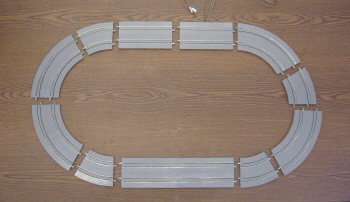 EasyTrolley N scale street sections forming a basic double-track loop. | The resulting "EasyTrolley" concept offers immediate gratification and opens up the formerly specialized trolley modeling field to many more people. Prototypically accurate double track operation with end or intermediate return loops can be created and arranged very flexibly. The track and street pieces are assembled with reversible glues into street sections. These sections can then be arranged and rearranged into many layouts. They can form your home layout, which you can set up temporarity or change at any time. You can also disassemble it and bring your pieces and buildings to a trolley meet to combine with others' into a larger layout. If you have ever worked with sectional slot car track, the concept is the same. For more information, see the Tomix Modelers website at www.trainweb.org/tomix/, as well as the Tomix and nscaletraction Yahoo discussion groups at groups.yahoo.com |
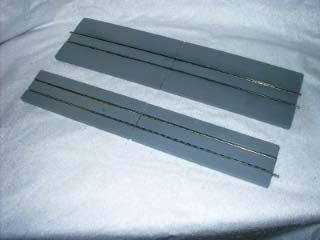 HO street track, built with flex track and Pennsylvania Heritage Models street pieces. (PHM photo) | Something similar can be accomplished in HO scale, using straight and curved street pieces now sold by Pennsylvania Heritage Models in both brick and cobblestone colors. Flex track is cut to suit and assembled into the plastic street pieces to create single-track street trackage. These sections can then be joined together to form a loop or other layout shapes. With some cutting and splicing, even more can be done. |
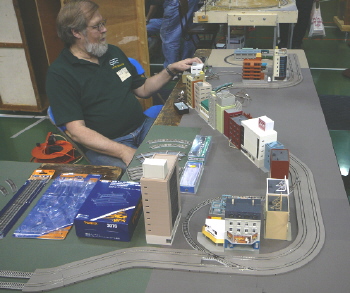
| This photo by Bob Tomasko shows the initial N scale EasyTrolley demonstration layout at the East Penn National Model Trolley Meet in May 2007. The street trackage is extensible at either end. The layout was assembled, then when other participants showed up later, quickly broken apart and reassembled to add their street pieces and enlarge the layout. It took less than five minutes to do this, including rearranging the buildings that provide the scenic backdrop to the LRV operations. Believe it or not, the model railcars are very easy to place on the rails, since the street surface supports them until the wheels are over the flangeways and drop right in! You do not have to be nearsighted to enjoy model traction in N scale... |